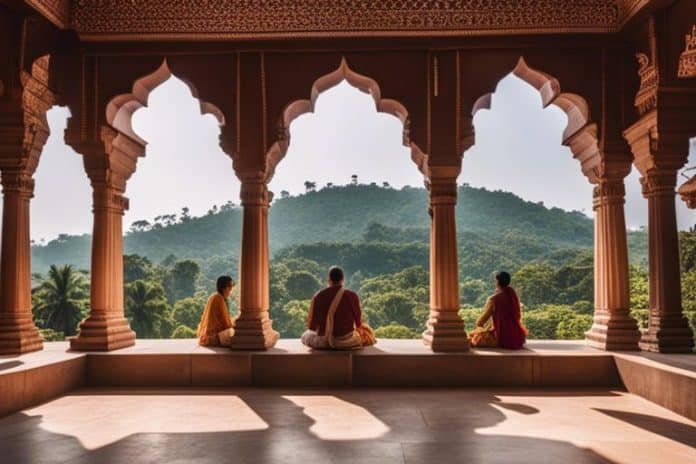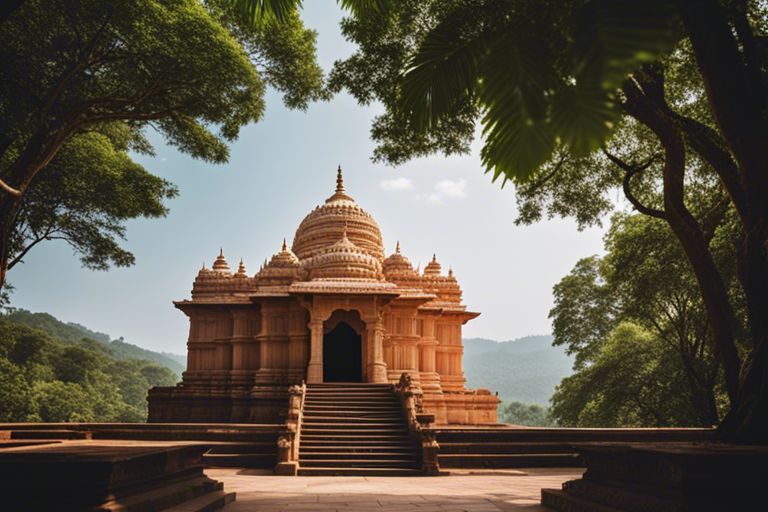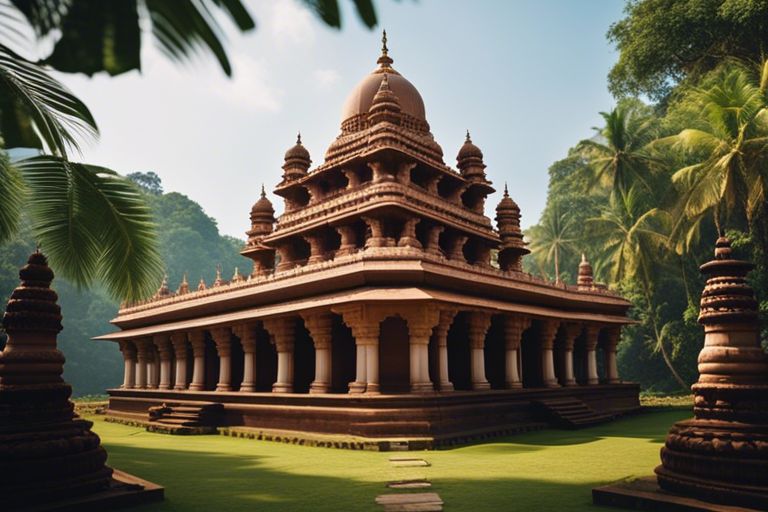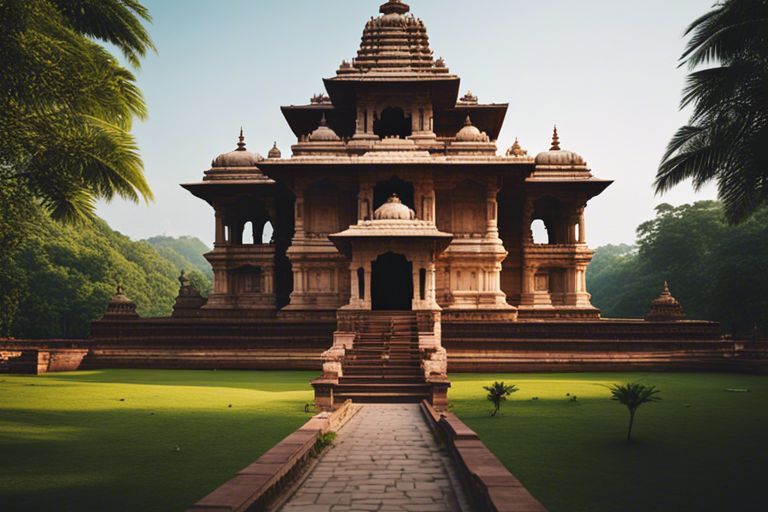Over centuries, India has been home to some of the most significant and sacred temples in the world, attracting millions of pilgrims and spiritual seekers. These temples not only showcase stunning architecture and intricate designs but also hold deep spiritual significance for visitors. Discovering the top temples in India can be a transformative journey for those seeking a spiritual retreat for the soul.
From the majestic temples in South India, such as the Brihadeeswarar Temple in Thanjavur and the Meenakshi Amman Temple in Madurai, to the peaceful temples nestled in the Himalayas, like the Badrinath Temple and the Kedarnath Temple, each temple offers a unique experience and a chance for introspection and connection with the divine. Whether you are drawn to the ancient temples of Varanasi or the architectural wonders of Khajuraho, India’s temples cater to a wide range of spiritual interests and beliefs.
Visiting these top temples in India requires a sense of respect and reverence for the culture and traditions they embody. With a rich history and deep religious roots, these temples offer not only a glimpse into India’s past but also a profound spiritual experience that can rejuvenate the mind, body, and soul. Whether you are seeking peace and tranquility or simply exploring the beauty of Indian architecture, a spiritual journey to India’s top temples is sure to leave a lasting impact on your soul.
Key Takeaways:
- Varanasi: Known as the spiritual capital of India, Varanasi is home to the revered Kashi Vishwanath Temple.
- Golden Temple: Located in Amritsar, this temple is a significant spiritual and cultural landmark for Sikhs.
- Meenakshi Temple: Situated in Madurai, this temple is dedicated to Goddess Meenakshi and showcases stunning Dravidian architecture.
- Lotus Temple: Located in Delhi, this Bahá’í House of Worship is renowned for its lotus-like structure and welcoming atmosphere.
- Khajuraho Temples: These UNESCO World Heritage sites in Madhya Pradesh feature exquisite temple art and intricate carvings.
- Shore Temple: Found in Mahabalipuram, this temple by the sea is a marvel of Pallava architecture and a popular pilgrimage site.
- Jagannath Temple: Situated in Puri, Odisha, this temple is dedicated to Lord Jagannath and hosts the famous Rath Yatra festival.
Preparing for Your Spiritual Journey
While begining on a spiritual journey to visit the top temples in India, it is imperative to prepare yourself for the profound experience that awaits you. The spiritual side of India can be a transformational experience, as mentioned in Discovering India’s Spiritual Side in Its Temples – MyNation. To make the most of your temple visits, consider key factors that will enhance your trip.
Key Factors to Consider When Planning Your Trip
- Research the significance of each temple you plan to visit to understand its historical and spiritual importance.
- Check the dress code requirements of the temples to ensure you are appropriately attired for the visit.
- Plan your itinerary wisely to allow for sufficient time at each temple without feeling rushed.
Knowing these key factors will help you approach your spiritual journey with a deeper level of appreciation and understanding.
Tips for a Respectful Temple Visit
- Remove your shoes before entering the temple premises to show respect for the sacred space.
- Avoid wearing revealing clothing to maintain the sanctity of the spiritual environment.
- Refrain from taking photographs in areas where it is prohibited to preserve the spiritual ambiance.
Recognizing and following these tips will ensure that you engage in a respectful and meaningful temple visit.
Preparing for a temple visit involves more than just physical readiness; it also requires mental and spiritual preparedness. It is imperative to approach the experience with a reverent attitude, understanding the significance of the rituals and practices you may encounter. Recognizing the importance of respecting the traditions and beliefs of the temple devotees is crucial to having a fulfilling and spiritually enriching journey.
Northern India: Temples That Touch the Sky
The Majestic Amarnath Cave Temple – A Holy Pilgrimage
Unlike any other temple in India, the Amarnath Cave Temple holds a special place in the hearts of devotees. Located in the Himalayas, this temple is dedicated to Lord Shiva and is surrounded by snowy peaks, creating a serene and mystical atmosphere. The journey to the cave temple is not for the faint-hearted, as it involves a challenging trek through rough terrain and unpredictable weather conditions. However, the breathtaking beauty of the surroundings and the spiritual significance of the temple make it a deeply rewarding experience for pilgrims.
The Amarnath Cave Temple is known for the ice lingam, a naturally formed stalagmite that is believed to represent Lord Shiva. During the annual pilgrimage known as the Amarnath Yatra, thousands of devotees make the arduous trek to pay their respects to the ice lingam. The cave itself is filled with an aura of mystery and devotion, enhancing the spiritual journey for visitors. It is a place where believers come to seek blessings and find inner peace amidst the tranquil surroundings.
Despite the challenges posed by the journey, the Amarnath Cave Temple remains a popular destination for those seeking a deep spiritual connection with Lord Shiva. The temple’s remote location and the reverence associated with it make it a place where devotees can truly immerse themselves in prayer and meditation, away from the distractions of everyday life.
Vaishno Devi: A Testament of Faith and Perseverance
While the Amarnath Cave Temple is known for its remote and rugged setting, Vaishno Devi Temple in Jammu is revered for its significance as a testament of faith and perseverance. This temple is dedicated to Goddess Shakti and is situated in a cave in the Trikuta Mountains. Pilgrims believe that a visit to the Vaishno Devi Temple fulfills their wishes and brings them closer to the divine.
For devotees, the journey to Vaishno Devi Temple is not just a physical trek but also a spiritual odyssey that tests their determination and devotion. The steep ascent to the cave shrine symbolizes the obstacles and challenges that one must overcome in order to attain spiritual enlightenment. Despite the arduous journey, pilgrims flock to the temple throughout the year, seeking blessings and solace in the divine presence of Goddess Vaishno Devi.
Faith plays a crucial role in the pilgrims’ experience at Vaishno Devi Temple, as they surrender themselves completely to the divine power of Goddess Vaishno Devi. The temple’s serene ambiance and the awe-inspiring natural surroundings create a sense of tranquility and devotion among visitors, making it a place where faith is reaffirmed and miracles are believed to happen.
The Architectural Marvels of Central India
Understanding the Intricate Design of Khajuraho Temples
After exploring the spiritual significance of these temples, it is crucial to examine into their architectural brilliance. The Khajuraho Temples in Madhya Pradesh stand out for their intricate design and exquisite carvings. Built between 950 and 1050 AD during the Chandela dynasty, these temples are a UNESCO World Heritage Site. The temples are known for their stunning sculpture work that depicts various aspects of human life, gods, and goddesses.
For those with an eye for detail, the temples’ architectural layout is no less than a masterpiece. The intricate designs on the walls tell stories of love, war, and spirituality. The layout of the temples follows a distinct pattern with spires, halls, and sculptures that leave visitors in awe. Each temple at Khajuraho is a unique representation of the architectural finesse of that era.
The Khajuraho Temples are not just beautiful structures; they are a testament to the exceptional craftsmanship of ancient India. The temples’ intricate carvings and detailed sculptures showcase the artistic skills of the artisans who worked on them. Visitors can spend hours marveling at the stunning design and soaking in the spirituality that permeates the air.
The Holiness of Mahakaleshwar Jyotirlinga
You may have heard about the twelve Jyotirlingas, believed to be the most sacred abodes of Lord Shiva. Among these, the Mahakaleshwar Jyotirlinga in Ujjain holds a special significance. Devotees believe that a darshan (sight) of this lingam can wash away sins and grant moksha (liberation). The temple is situated on the banks of the Shipra River and draws pilgrims from far and wide.
For those seeking spiritual solace, a visit to Mahakaleshwar Jyotirlinga is a must. The temple’s serene ambiance and the rhythmic chants of Shiva mantras create an atmosphere of divine grace. The lingam is said to be self-manifested and exudes a powerful energy that resonates with devotees. The holiness of the place is palpable, making it a profound spiritual destination.
You can witness the daily rituals and aarti (prayer) ceremonies that take place at the temple, adding to the overall spiritual experience. Devotees often stand in long queues to get a glimpse of the sacred lingam and offer their prayers to Lord Shiva. The Mahakaleshwar Jyotirlinga is not just a temple; it is a place where devotees connect with the divine and find inner peace.
Understanding More About The Holiness of Mahakaleshwar Jyotirlinga
Named after the Mahakal form of Lord Shiva, this Jyotirlinga is believed to be swayambhu (self-manifested) and holds immense spiritual significance. It is said that the lingam embodies the essence of time and destruction, representing the cycle of creation and annihilation. Devotees flock to the temple to seek blessings and pay homage to the eternal power of Lord Shiva.
Eastern India: The Hub of Spiritual Enlightenment
Despite India being a land of numerous temples, Eastern India stands out as a hub of spiritual enlightenment. This region is home to some of the most revered temples that attract pilgrims and tourists alike seeking spiritual solace and cultural experiences.
The Ancient Wonders of Konark Sun Temple
Even amidst the diverse array of temples in Eastern India, the Konark Sun Temple holds a special place. Known as the ‘Black Pagoda’, this UNESCO World Heritage Site is a marvel of ancient architecture dedicated to the Sun God. The temple’s intricate stone carvings depict celestial beings, animals, and floral motifs with breathtaking detail and precision. The imposing chariot structure is adorned with sculptures of 24 wheels each signifying hours of the day, showcasing the genius of ancient Indian craftsmanship.
The mythical significance of the Konark Sun Temple adds to its allure. Legend has it that the temple was built in the shape of a grand chariot with the Sun God as the charioteer, driven by seven horses representing the days of the week. Visitors can feel a sense of timelessness and spiritual energy as they explore this architectural masterpiece, making it a must-visit for those on a spiritual quest.
The majestic silhouette of the Konark Sun Temple against the backdrop of the Bay of Bengal makes for a mesmerizing sight, especially during sunrise and sunset. The temple’s mystical aura and historical significance make it a destination that showcases the rich cultural tapestry of Eastern India.
The Serenity of Jagannath Temple, Puri
Even in a region teeming with spiritual landmarks, the Jagannath Temple in Puri stands out for its peaceful ambiance and deep-rooted traditions. Dedicated to Lord Jagannath, an incarnation of Lord Vishnu, this temple is a spiritual oasis for devotees seeking blessings and enlightenment. The temple is not just a religious site but a cultural epicenter hosting vibrant festivals like the Rath Yatra that draw devotees from far and wide.
The magnificent architecture of the Jagannath Temple reflects the grandeur of Odisha’s architectural heritage. The temple complex is a testament to ancient design principles and craftsmanship, with intricate carvings adorning its walls. Pilgrims and visitors can immerse themselves in the sacred atmosphere of the temple, participating in rituals and prayers that have been carried out for centuries.
Solar despite its popularity, the Jagannath Temple maintains a sense of serenity that is rare to find in bustling pilgrimage sites. The temple’s serene surroundings and spiritual significance make it a haven for those seeking inner peace and divine blessings in the heart of Eastern India.
Southern India: Embracing the Dravidian Grandeur
Once again, if you are seeking spiritual enlightenment and a deep connection to India’s cultural heritage, Southern India beckons with its rich tapestry of temples and sacred sites. Embark on a journey to this region, following the footsteps of ancient civilizations and soaking in the aura of divinity that permeates the air. For senior travelers looking for a transcendent experience, the article ‘ 5 Spiritual Journeys In India Senior Travelers Must Take‘ is a must-read guide to exploring the spiritual gems of India.
Exploring the UNESCO Heritage Site: Meenakshi Amman Temple
You step into a world where myth and legend intertwine with architectural marvel. The Meenakshi Amman Temple in Madurai stands as a testament to the Dravidian grandeur, with its towering gopurams (gateway towers) intricately carved with scenes from Hindu mythology. As you wander through the temple complex, the exquisite craftsmanship and spiritual significance of each sculpture will leave you in awe.
Devotees and visitors alike are drawn to the sanctum sanctorum where the presiding deities, Meenakshi and Sundareswarar, are adorned with ornate jewels and vibrant garlands. The energy within the temple is palpable, a fusion of devotion and history that transcends time. Make sure to witness the evening aarti (prayer ceremony) that bathes the temple in a mystical glow.
Exploring the Meenakshi Amman Temple is not just a sightseeing excursion; it is a spiritual journey that explores into the essence of faith and artistry. The temple’s sacred tanks, pillared halls, and bustling bazaars surrounding it create a melting pot of culture and spirituality, inviting you to experience a profound connection with the divine.
The Tranquil Boundaries of Rameshwaram: A Pilgrim’s Paradise
Clearly, Rameshwaram is more than just a physical location; it is a sanctuary for seekers of truth and solace. Nestled on an island off the southeastern coast of Tamil Nadu, Rameshwaram is revered for its legendary connections to the epic Ramayana and its purifying waters that are said to absolve sins.
Western India’s Treasures: From Gurjara to Maratha Architectural Gems
Many travelers seeking spiritual solace in India often overlook the architectural marvels that adorn Western India. From the intricacies of Gurjara-Pratihara temples to the grandeur of Maratha constructions, this region is a treasure trove of architectural wonders that reflect India’s rich cultural heritage.
Experiencing the Power of Shirdi Sai Baba Temple
Treasures of Western India include the spiritual oasis that is the Shirdi Sai Baba Temple. This revered shrine, located in the town of Shirdi in Maharashtra, is a sanctuary for devotees seeking solace and enlightenment. The temple is dedicated to the revered saint Sai Baba, whose teachings of love, peace, and charity continue to inspire millions around the world.
Visitors flock to this sacred site to seek blessings, offer prayers, and experience the divine presence believed to reside within the temple precincts. The atmosphere at the Shirdi Sai Baba Temple is imbued with a sense of peace and tranquility, making it a perfect place for spiritual rejuvenation and introspection.
Devotees often participate in rituals such as aarti and prasad distribution, immersing themselves in the spiritual energy that permeates the air. The temple complex also houses a museum showcasing Sai Baba’s personal belongings and artifacts, offering a glimpse into the life of this revered saint.
The Timeless Appeal of Dwarkadhish Temple
The city of Dwarka in Gujarat is home to one of the most significant Hindu pilgrimage sites in India – the Dwarkadhish Temple. Believed to be one of the Char Dham pilgrimage sites, this temple dedicated to Lord Krishna attracts devotees from far and wide, seeking blessings and spiritual fulfillment.
For instance, the architecture of Dwarkadhish Temple is a fine example of ancient Indian craftsmanship, with intricate carvings and elaborate designs adorning its structure. The temple’s sanctum sanctorum houses the idol of Lord Krishna, a sight that fills devotees with devotion and reverence.
Visitors to the Dwarkadhish Temple can partake in various rituals and ceremonies, including the evening aarti that fills the temple complex with melodious chants and hymns, creating a truly divine ambiance. The spiritual significance of this temple, coupled with its architectural splendor, makes it a must-visit destination for anyone seeking a deeper connection with the divine.
Lesser-Known Hidden Gems of India
The Spiritual Solitude of Bateshwar Temples
Keep the tranquil town of Bateshwar on your list of spiritual retreats in India, as it houses a collection of ancient temples that exude a serene aura. Nestled along the banks of the Yamuna River in Uttar Pradesh, the Bateshwar Temples are a lesser-known gem that offer visitors a quiet escape from the hustle and bustle of modern life. The cluster of temples, numbering over a hundred, is believed to date back to the 8th century and showcases exquisite architectural craftsmanship.
For those seeking spiritual solitude and a deeper connection with their inner selves, Bateshwar Temples provide the perfect setting. The peaceful ambiance of the temples, coupled with the picturesque surroundings, creates an ideal environment for meditation and reflection. Visitors can explore the intricate carvings and sculptures that adorn the temples, each telling a story from ancient mythology.
Take a step back in time and immerse yourself in the spiritual energy that permeates the air at Bateshwar Temples. Away from the tourist crowds, this hidden gem offers a peaceful retreat where one can experience a sense of tranquility and connect with the divine in a profound way.
The Mystical Vibes of Aihole and Pattadakal
Assuming a central place in the cradle of temple architecture in India, Aihole and Pattadakal in Karnataka are mystical destinations that captivate the soul. These ancient temple complexes boast a rich history and showcase a blend of architectural styles that reflect the cultural heritage of the region. Aihole, known as the “cradle of Indian architecture,” features over a hundred temples that exhibit Dravidian and Nagara styles.
Some of the most striking temples in Aihole include the Durga Temple, Lad Khan Temple, and Ravalphadi Cave Temple, each offering a glimpse into the artistic brilliance of ancient craftsmen. Nearby, Pattadakal is a UNESCO World Heritage Site known for its group of monuments that blend architectural influences from northern and southern India. The intricately carved temples at Pattadakal, such as the Virupaksha Temple and Mallikarjuna Temple, are testaments to the grandeur of Chalukyan art.
To truly appreciate the mystical vibes of Aihole and Pattadakal, visitors can partake in guided tours that unravel the historical significance of these architectural wonders. Delve into the stories behind each temple, marvel at the intricate carvings depicting scenes from Hindu mythology, and soak in the spiritual essence that permeates these sacred grounds.
Modern Temples: The New Age Spirituality
The Art of Living International Center: A Retreat for the Spirit
Not all temples in India are ancient. Some, like The Art of Living International Center, are a testament to modern spirituality and the pursuit of inner peace. Located in Bangalore, this center offers a retreat for the soul amidst the bustling urban landscape. Founded by spiritual leader Sri Sri Ravi Shankar, the center provides a haven for individuals seeking to reconnect with their spiritual selves.
Little do visitors know that within the serene surroundings of the center lies a wealth of spiritual teachings and practices. From yoga and meditation to ancient breathing techniques, the center offers a holistic approach to well-being. The lush greenery and tranquil atmosphere make it a perfect place for introspection and self-discovery.
Visitors can partake in various workshops and courses led by experienced instructors, diving deep into the realms of mindfulness and consciousness. The center also hosts large-scale events and festivals that attract spiritual seekers from around the world.
Akshardham Temple: A Blend of Spirituality and Technology
Living in the age of technology doesn’t mean disconnecting from spirituality, as showcased by the Akshardham Temple in Delhi. An architectural marvel, this modern temple seamlessly blends spirituality and technology to create a truly immersive experience for visitors. Every corner of the temple is adorned with intricate carvings and designs that tell sacred stories of ancient wisdom.
An epitome of modern Indian architecture, the temple boasts a stunning light and sound show that brings to life the spiritual essence of the teachings enshrined within its walls. The intricate details and grandeur of the temple leave visitors in awe, fostering a sense of reverence and wonder.
One of the key attractions of Akshardham Temple is the cultural boat ride that takes visitors through millennia of Indian history and spirituality. The blend of technology and artistry creates a mesmerizing journey that leaves a lasting impact on all who experience it.
Fostering a Sustainable Temple Tourism Environment
All travelers should strive to leave a positive impact on the destinations they visit. Concerning experiencing the spiritual and cultural richness of India’s temples, responsible tourism plays a crucial role in preserving these sacred sites for future generations. Responsible tourism involves being mindful of the environment, local communities, and cultural heritage while traveling. By adopting sustainable practices and respecting the rules and customs of the temples, visitors can contribute to the preservation efforts and ensure that these spiritual retreats remain intact for years to come.
The Role of Responsible Tourism in Temple Preservation
Even small actions, such as properly disposing of waste, conserving water, and respecting the silence and sanctity of the temple premises, can make a significant difference in maintaining the integrity of these ancient sites. Engaging in responsible tourism also means supporting local artisans and businesses, thus contributing to the economic sustainability of the surrounding communities. By treading lightly and showing reverence for the cultural significance of the temples, visitors can actively participate in the preservation of these sacred spaces.
Engaging with Preservation Efforts for Ancient Sites
There’s a growing need for active engagement in preservation efforts for ancient sites across India. From participating in volunteer programs that focus on temple conservation to donating to organizations dedicated to heritage protection, there are various ways for travelers to get involved. By understanding the historical and cultural importance of these temples and supporting initiatives that aim to safeguard them, visitors can contribute to the sustainable preservation of India’s architectural wonders.
Conclusion
Upon reflecting on the top temples in India, one cannot help but be overwhelmed by the sheer beauty, complexity, and spiritual significance that each one holds. From the iconic Golden Temple in Amritsar to the serene Kedarnath Temple nestled in the Himalayas, these temples offer a profound spiritual retreat for the soul. Each temple has its own unique history, architectural style, and cultural significance that showcases the rich tapestry of India’s religious heritage.
Visiting these temples is not just a physical journey but a deeply transformative experience that allows one to connect with the divine and find inner peace. Whether you are seeking solace, enlightenment, or simply a moment of tranquility, the top temples in India offer a sacred space for all to explore their spiritual beliefs and deepen their connection to the divine. The intricate carvings, vibrant rituals, and soul-stirring chants in these temples transport visitors to a realm of spirituality that is both captivating and rejuvenating.
As you commence on a spiritual journey through the top temples in India, may you find solace in the timeless traditions, profound wisdom, and boundless devotion that these sacred sites embody. Let the spiritual energy of these temples cleanse your mind, uplift your spirit, and awaken your soul to the infinite possibilities that lie within. Discover the magic of India’s temples as you commence on a transformative pilgrimage that will leave an indelible mark on your heart and soul.
FAQ
Q: What makes temples in India special for spiritual retreats?
A: Temples in India hold deep spiritual significance and are considered sacred places where one can connect with higher powers and find inner peace.
Q: How many temples are there in India?
A: It is estimated that there are over 2 million temples in India, each offering a unique spiritual experience.
Q: What are some of the top temples to visit in India?
A: Some of the top temples in India include the Golden Temple in Amritsar, Vaishno Devi Temple in Jammu, and Meenakshi Temple in Madurai.
Q: Are there any specific rituals one should follow when visiting a temple in India?
A: It is important to follow certain rituals such as removing shoes before entering the temple, dressing modestly, and showing respect to the deities and priests.
Q: How can visiting temples in India benefit one’s spiritual well-being?
A: Visiting temples in India can help individuals find inner peace, gain spiritual insights, and experience a sense of calmness and tranquility.
Q: What is the best time to visit temples in India?
A: The best time to visit temples in India is during festivals and auspicious occasions when the temples are beautifully decorated and vibrant with spiritual energy.
Q: How can one make the most of their spiritual retreat at a temple in India?
A: To make the most of a spiritual retreat at a temple in India, one should approach the visit with an open mind, participate in rituals, seek blessings from the deities, and spend time in quiet contemplation and meditation.




